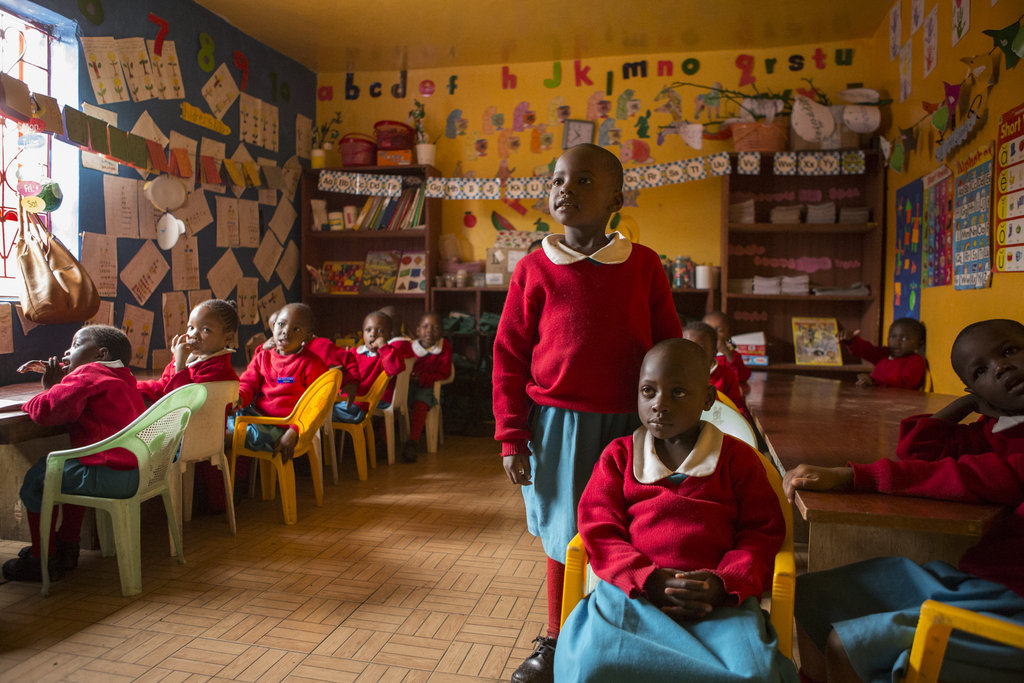
Yesterday we at last visited Shofco at their Mathare center. Albert, a Shofco employee, met us just outside the neighborhood and led our caravan in.
According to Albert’s count, the community numbers several hundred thousand, and is nestled mainly in a low valley between two ridges (up which businesses and houses have begun to climb). On the way in we pass a volleyball court — with a live game going on – overlooking a long, flat soccer pitch. As we come nearer the center, we see a prismatic stream of school jerseys: vivid greens, purples, blues, and reds. Albert informs us that there are many, many schools in Mathare. Naturally, he favors Shofco, among them, and he’s quick to point out the Shofco kids in the parade of sweaters.
The Shofco building is massive, and strikes the eye immediately, wearing accents of its trademark blue and rising over the band of one-story buildings. The Mathare center features several floors of classrooms, offices, a library, and a large meeting room where we performed.
One odd aspect of being on tour is that you rarely get to experience the places you visit at any level of depth. You fly in for the night (or, in our case, drive in for the day), do your show, chat a bit, and then you’re on to the next gig. I’m reminded of Wilfrid Brambell’s character in A Hard Day’s Night complaining (in what I’ve heard is an actual John Lennon quote), “so far, I’ve been in a train and a room, and a car and a room, and a room and a room.”
That feeling cropped up again today as we bumped along through the streets of Mathare. There’s no doubt we are outsiders and we ought to take seriously our local contacts’ safety warnings and advice about how to approach the schools we visit. But when you’re a couple of groups of largely American tourists in white and silver vans, with tinted windows, occupying 90% of the narrow main road, waving at chasing children, and peeking into every home and business you pass, you can’t help but wonder if it wouldn’t be less disruptive or invasive to simply walk in.
And when you leave your hosts, their school, and their neighborhood after four hours, you can’t help but wonder if there’s another way to arrange this experience of sharing. Our hope, as we discussed many weeks ago in New York, was that these shows and discussions could be events of free and open exchange beginning with our sharing of this Antigone we’ve made. We all want, I think, to make a connection that is mutual. But that’s hard to achieve when we are basically ignorant of the places and people we meet, and when there are barriers — of language and manners and other kinds — we have not yet learned to surmount, and when finally we are in and out like a shot.
Were this a visit to Nairobi for the purpose of scholarship, or charity, or diplomacy, the answer would be simple: one needs to spend more time – months, years, in a community, even, to understand. One needs to be out in the city rather than in a plane and a van and a room and a van. But it’s difficult to see how that might work in the context of a theatrical tour. Certainly something we might think about as we plan for the future life of Antigone In The World.
Today’s journey took us to the original Shofco center in Kibera, and this time we did walk in – at least the last quarter mile. In comparison to the Mathare center, which is one large school building, Shofco Kibera is a more complex and multi-limbed operation. The main building, where we performed, houses Kibera School For Girls. To the left of the entrance is the water supply, operated under the aegis of Shofco’s Clean Water and Sanitation Initiative. There, water is constantly pumped into large yellow cans and carried off to others facilities, and presumably nearby homes. The 100,000 liter tower that supplies both the water and its pressure peaks up above the roofs of surrounding houses and is the first thing one sees from a distance. Beside the school, in various out-buildings, are the kitchen – where a crew of women work tirelessly to cook for and clean up after more than 200 girls – the toilets, the administrative offices, and the Johanna Justin-Jinich Community Clinic, a free clinic that serves 170 patients a day.
The auditorium, painted a rich yellow, is smaller than the room from yesterday and features a central column that required us to tighten our playing area still further. The result, especially after packing in more than 150 people – most of them young girls – was quite an intimate performance.
As it happened, I got to see very little of the play because I was outside minding traffic through the door. We’ve found that large groups of children tend to wander at their will (who would have thought?), and so yesterday Benita was door cop, and today the job fell to me.
I did, however, get to see our exciting new introduction to the show.
Last night over dinner and drinks, Peter, Marcel, Mosher, and I discussed the struggles we’ve had to make the play comprehensible for young audiences. It was suggested that for the next show we might try telling the kids the whole story in advance. Peter leaped in with an even better idea: we would have the kids themselves perform the story, in miniature. He and Marcel have both trained in what they call Whoosh Storytelling as part of Classic Stage Company’s Young Company program, which brings classic plays to young audiences, including ESL students, in New York. They broke it down quickly for Greg and me: you cast the kids in the roles of the play; you give them something to identify each of them – in New York it was name cards, but here we could use costume pieces — and then you have them act out the skeleton of the story in tiny, digestible bites.*
For example, our first several beats, on this trial edition were:
- We are now in the City Of Thebes.
- Two brothers – the good brother Eteocles, and the bad brother Polynices are fighting for control of the city. They fight and kill each other.
- Their Uncle Kreon makes himself king and declares a law that the good brother Eteocles should be buried, but the bad brother Polynices should be left for the dogs to eat.
- The two dead boys have two sisters, Antigone and Ismene. Antigone wants to break the law and bury the bad brother Polynices, but Ismene says no.
And so eventually the play is summed up in twelve beats, with the kids acting out each one.
*(By the way, I think every director’s dream is that the actors engage the project with as much creative passion and ownership as the director him or herself does, and so I can only imagine how proud Mosher must have been to watch Marcel and Peter go hammer and tong at crafting this Whoosh Story. I saw two formidable actors turn all their energy and intelligence onto a task that benefitted the play even though it was outside their strict job description)
Marcel and Peter are both instant hits with children, and their volunteer troupe of actors seemed to have a great time providing the rest of the audience with a preview of the play. Even better, the Whoosh Story appeared to be very successful in helping the whole young audience follow the action of Antigone.
Once that was done, I was stuck outside the doors, serving as a bit of a coat rack for the various props and costume bits discarded throughout the show. I watched trains of boys and women fill at least 50 of the giant yellow water cans from the pump room. And I made friends with a nine-year-old girl named Ann, who seemed too shy to pass through the doors and sit for the show.
Ann stood by the wall next to me, placing her palm over the various paint hand-prints that decorate the blue façade. She would peak occasionally through the doorway or through a window near the back of the house and return to me with questions about the actors. Her dark blue sweater marked her out from the Kibera School girls, who dress in bright red. Ann told me she attends Olympic and had come to Shofco because her mom was in hospital with malaria. She disappeared occasionally throughout the performance, maybe to check on her mother or see what was around the corner, but always came back, squeezing under several men to peer through the window, insisting she had once again forgotten my name and what did I call myself?
When the show ended, Kennedy Odede sought feedback from the young people about what they had learned from the play. After several responses, he told the crowd that he himself was reminded of the difficult time in his life, filled with painful loss, that led to the creation of Shofco. What he took away was that you have to stand for your truth, even if you stand alone.
The chairs were removed and crowds of kids were free to gather around the actors. Marcel had a horde of thirty girls buzzing around him, lobbing him questions. Suddenly he began to serenade one of the older girls, and the whole mob just about levitated.
Sidling the edge of the dance circle that soon formed, I spotted Ann in her navy sweater. She had at last come inside but wandered her own orbit, still too shy, maybe, to join the group. I tried to introduce her to Kea, across the room, but Ann put her sleeve over her mouth and planted her feet.
When I emerged later into the hot sun carrying my backpack and a suitcase of props, I looked for her to say goodbye. But she was gone again to her mother. And we were on the road.
-Steve Foglia
Header Image taken from Shofco progress report August 2012


